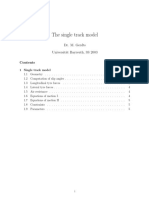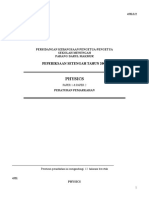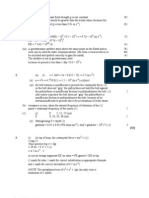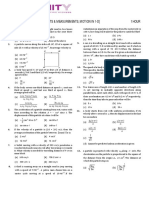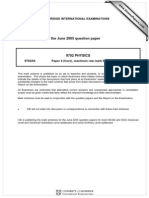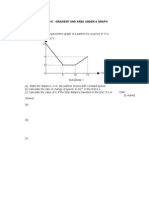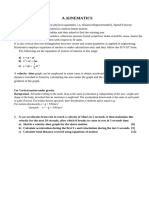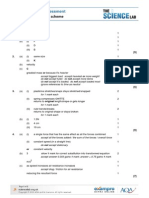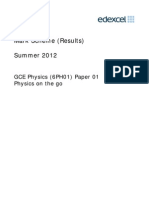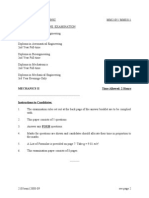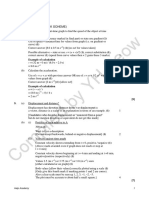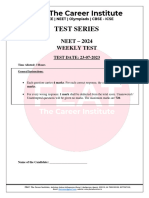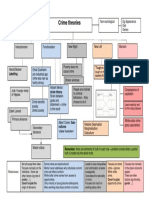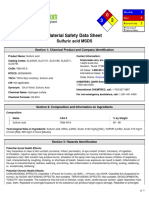0 ratings0% found this document useful (0 votes)
128 viewsMark Scheme Forces
Mark Scheme Forces
Uploaded by
Steve BishopThis document contains a mark scheme for multiple choice and written physics questions. For question 1a, the correct resultant force is 1500N. For question 2a, the order of choices A, E is A then E. As speed increases, drag force increases until it equals thrust force, at which point the car reaches its top speed. The car has a higher top speed than the van because it is more streamlined.
Copyright:
© All Rights Reserved
Available Formats
Download as PDF, TXT or read online from Scribd
Mark Scheme Forces
Mark Scheme Forces
Uploaded by
Steve Bishop0 ratings0% found this document useful (0 votes)
128 views11 pagesThis document contains a mark scheme for multiple choice and written physics questions. For question 1a, the correct resultant force is 1500N. For question 2a, the order of choices A, E is A then E. As speed increases, drag force increases until it equals thrust force, at which point the car reaches its top speed. The car has a higher top speed than the van because it is more streamlined.
Copyright
© © All Rights Reserved
Available Formats
PDF, TXT or read online from Scribd
Share this document
Did you find this document useful?
Is this content inappropriate?
This document contains a mark scheme for multiple choice and written physics questions. For question 1a, the correct resultant force is 1500N. For question 2a, the order of choices A, E is A then E. As speed increases, drag force increases until it equals thrust force, at which point the car reaches its top speed. The car has a higher top speed than the van because it is more streamlined.
Copyright:
© All Rights Reserved
Available Formats
Download as PDF, TXT or read online from Scribd
Download as pdf or txt
0 ratings0% found this document useful (0 votes)
128 views11 pagesMark Scheme Forces
Mark Scheme Forces
Uploaded by
Steve BishopThis document contains a mark scheme for multiple choice and written physics questions. For question 1a, the correct resultant force is 1500N. For question 2a, the order of choices A, E is A then E. As speed increases, drag force increases until it equals thrust force, at which point the car reaches its top speed. The car has a higher top speed than the van because it is more streamlined.
Copyright:
© All Rights Reserved
Available Formats
Download as PDF, TXT or read online from Scribd
Download as pdf or txt
You are on page 1of 11
Mark scheme forces
M1. (a) 1.25
allow 1 mark for correct resultant force ie 1500N
allow 2 marks for correct transformation and substitution
ie
3
m/s
2
1
(b) as speed increases so does the size of the drag force
1
eventually the drag force becomes equal to the thrust
1
the resultant force is now equal to zero and therefore
there is no further acceleration
1
(c) the car and van will reach top speed when the forward
force equals the drag force
accept air resistance / frictional / resistive force for drag force
1
the drag force at any speed is smaller for the car than
for the van
1
as the car is more streamlined
1
therefore the cars drag force will equal the forward force
at a higher speed
1
[11]
M2. (a) A then E
1
(b) A > E
A = E
A < E
in this order 3
(c) when van stops / is stationary / is parked
1
(d) WX slowing down
XY constant speed
YZ speeding up
for 1 mark each
3
(e) .. force . forwards . backwards
for 1 mark each
3
[11]
M3. (a) W = 65 10
PE change = 650 1.25 or 65 10 1.25
gains 3 marks
but
PE change = 812.5 (J) (allow 813J or 812J)
gains 4 marks
4
(b) k.e. = p.e.
gains 1 mark
but
(speed) = 812.5 2 / 65 or 812.5 = 65 (speed) ecf
gains 2 marks
but
speed = 5 (m/s) (allow 4.99 5.002)
(if answer = 25mls check working: 812.5 = m v gains 1 mark for
KE = PE)
(but if 812.5 = m v = 65 v
2
or v
2
= gains 2 marks)
25, with no working shown gains 0 marks
gains 3 marks
3
[7]
M4. (a) (i) tiredness / boredom
drugs
alcohol
distraction
any two for 1 mark each
2
(ii) A greater / longer
B no effect
C greater / longer
each for 1 mark
3
(b) on a wet road: there is less friction / grip
for 1 mark
braking distance is greater / takes longer to stop
or car skids / slides forward
for 1 mark
2
(c) (i) deceleration = gradient or 30 / 4.8
each for 1 mark
2
(ii) force = mass acceleration or 900 6.25
each for 1 mark
2
(iii) distance = area under graph or 0.5 4.8 30 or average
speed time or 15 4.8
Accept answer in terms of change in k.e. = work done
if incorrect unit given (eg 72km) then no mark
each for 1 mark
2
[13]
M5. (a) (i) air resistance/drag/friction (or upthrust)
weight/gravitational pull/gravity
for 1 mark each
1
(ii) air resistance/friction acts in opposite direction to motion
1
(iii) Y
1
(iv) the sky-diver accelerates/his speed increases
in downward direction/towards the Earth/falls
for 1 mark each
2
(b) force X has increased force Y has stayed the same the speed of the sky-diver
will stay the same
for 1 mark each
3
(c) (i) CD
1
3
(iv) 10 (but apply e.c.f. from (ii) and (iii))
gets 2 marks
or 500/50 or d/t
gets 1 mark
2
[14]
M6. (a) evidence of distance = speed time or 4 20
gains 1 mark
but
80
gains 2 marks
units m
for 1 mark
3
(b) idea that (both) become warm/hot
for 1 mark
idea of wearing (away/down)/becoming scratched
gains 1 mark
but
(brake) pads wear more (than wheel discs)
gains 2 marks
3
[6]
M7. (a) Each scale optimum
Else both half size
Straight line joining 30,0 to 30,0.67 to 0, 5.67
any 5 for 1 mark each
5
(b) 6
Else a = 30/5
gets 2 marks
Else a = v/t
gets 1 mark
3
(c) 9000
Else F = 6 1500
gets 2 marks
Else F = ma
gets 1 mark
3
(d) (i) Driver has forward momentum
Which is conserved
Giving drive relative forward speed to car
for one mark each
3
(ii) If inelastic ke lost
Here ke does work crumpling car
for 1 mark each
2
(iii) Car stops in 75m
gets 1 mark
W = F.d or 9000 75
gets 1 mark
W = 675 000 J
OR ke = 1/2 mv
2
gets 1 mark
ke = 1/2.1500.302
ke = 675 000 J
3
[19]
M8. (a) AB
for 1 mark
1
(b) (i) 0.7
for 1 mark each
1
(ii) 16.8
gains 2 marks
2
but correct working
(d = v.t, d = 24 0.7, or in terms of area under graph)
gains 1 mark
1
(c) a = (v-u)/t
= 24/4
= 6
m/s
2
(see marking of calculations)
(can work in terms of graph gradient)
4
(d) d = v.t
= 24/2 4
= 48
(see marking of calculations)
(can work in terms of area under graph)
3
(e) F = ma
= 800 6
= 4800
(see marking of calculations)
3
[15]
M9. (a) 3
gains 1 mark
m/s
2
gains 1 mark
else working gains 1 mark
2
(b) 2850 ecf
gains 1 mark
N
gains 1 mark
else working
gains 1 mark
2
(c) friction/air resistance increases with speed;
till frictional = max forward force;
then force/acceleration is zero
for 1 mark each
alternative limitation for safety
gains 1 mark only
3
[7]
M10. (a) points correct; line correct
for 1 mark each
2
(b) increases
for 1 mark
1
(c) (i) 9
for 1 mark
1
(ii) 6 ecf
for 1 mark
1
(iii) increased ecf
for 1 mark
1
[6]
M11. (i) C and D or D and C
accept CD
accept DC
accept answers in terms of time
1
(ii) any one from:
streamline position streamline clothes
accept crouched position
accept tight clothes
accept design of cycle
accept cycle slower
1
(iii) 0.5 hours or 30 minutes or 1800 seconds
must have unit
1
(iv) speed =
accept any correct rearrangement
accept s = d/t or v s/t
accept velocity for speed
accept
if subsequent use of correct
1
(v) 16
allow for mark for each of time = 3.5 hours
distance = 56km
allow e.c.f. from part (a)(iii) if correctly used
an answer of 14 gains 2 marks
allow 1 mark for correct attempt to average the three sections
3
[7]
M12. (a) (i) constant speed
do not accept normal speed
do not accept it is stopped / stationary
1
in a straight line
accept any appropriate reference to a direction
constant velocity gains 2 marks
not accelerating gains 2 marks
terminal velocity alone gets 1 mark
1
(ii) goes down owtte
accept motorbike (it) slows down
1
(b) (i) 20 (m/s)
ignore incorrect units
1
(ii) acceleration =
do not accept velocity for change in velocity
accept change in speed
accept or
or a =
do not accept
1
(iii) 4
or their (b)(i) 5
allow 1 mark for correct substitution
2
m/s
2
m/s/s or ms or metres per
second squared or metres per
second per second
1
(c) vehicle may skid / slide
loss of control / brakes lock / wheels lock
accept greater stopping distance or difficult to stop
1
due to reduced friction (between tyre(s) and road)
accept due to less grip
do not accept no friction
1
(d) any three from:
do not accept night time / poor vision
increased speed
reduced braking force
slower (driver) reactions
NB specific answers may each gain credit eg tiredness (1), drinking
alcohol (1), using drugs (1), driver distracted (1) etc
poor vehicle maintenance
specific examples may each gain credit eg worn brakes or worn tyres etc
increased mass / weight of vehicle
accept large mass / weight of vehicle
poor road surface
more streamlined
if candidates give three answers that affect stopping distance but not
specific to increase award 1 mark only
3
[13]
M13. (a) A = speeding up
[Accept accelerating / acceleration / going faster]
B =moving at a steady speed
[Accept constant speed]
C = slowing down
[Accept going slower / decelerating]
each for 1 mark
3
(b) acceleration =
NB if formula given must be correct
or
gains 1 mark
but 2.5
gains 2 marks
unit m/s
2
or metres per second squared
or metres per second per second
for 1 mark
or m/s
2
[Credit even if no / an incorrect numerical answer is given]
3
[6]
M14. (a) Quality of written communication
for correct use of term speed in all correct examples
Q Q
1
describes all 3 sections correctly for 2 marks
describes 2 or 1 section correctly for 1 mark
max 2
A B constant speed
do not accept pace for speed
B C (has accelerated) to a higher (constant) speed
C D goes back to original / lower (constant) speed
allow for 1 mark, initial and final (constant) speeds are the same accept
velocity for speed
ignore reference to direction
(b) 62.5
allow answer to 2 s.f.
allow 1 mark for drawing a correct triangle or for using two correct pairs
of coordinates
allow 1 mark for correct use of y/x
ignore units
3
[6]
M15. 1 mark for each line
if more than 1 line is drawn from a graph in List A then all those lines are
marked incorrect
[3]
M16. (a) 60
1
(b) 5 hours
must include unit
1
(c) 30
1
(d) 30 minutes or
hour
must include unit
1
(e) D and E
accept finish for E
accept correct numbers from axes with units
1
least steep part of the graph
accept covers smallest distance in a set time
accept only moves 5 km in 1 hours (accept anything between 5 and 6)
ignore horse is tired
1
[6]
M17. (a) (i) 4.5
allow 1 mark for correct substitution i.e. 9 2
2
(ii) m/s
2
accept answer given in (a)(i) if not contradicted here
1
(iii) speed
1
(iv) straight line from the origin passing through (2s, 9m/s)
allow 1 mark for straight line from the origin passing through to t = 2
seconds
allow 1 mark for an attempt to draw a straight line from the origin passing
through (2,9)
allow 1 mark for a minimum of 3 points plotted with no line provided if
joined up would give correct answer. Points must
include(0,0) and (2,9)
2
(b) (i) B
if A or C given scores 0 marks in total
1
smallest (impact) force
1
on all/ every/ any surfaces
these marks are awarded for comparative answers
1
(ii) (conditions) can be repeated
or
difficult to measure forces with human athletes
accept answers in terms of variations in human athletes e.g.
athletes may have different weights area / size of feet may be different
difficult to measure forces athletes run at different speeds
accept any answer that states or implies that with humans the conditions
needed to repeat tests may not be constant
e.g.
athletes unable to maintain constant speed during tests (or during repeat
tests)
do not accept the robots are more accurate
removes human error is insufficient
fair test is insufficient
1
[10]
M18. (a) 4.5
allow 1 mark for correct substitution ie 9 2
2
m/s
2
mark independently
1
(b) Marks awarded for this answer will be determined by the
Quality of Written Communication (QWC) as well as the
standard of the scientific response.
No relevant content.
0 marks
There is a brief description of the performance of the
running shoes on the three surfaces.
Level 1 (12 marks)
There is some description of the performance of the
running shoes on the three surfaces.
Level 2 (34 marks)
There is a clear, balanced and detailed description of the
performance of the running shoes on the three surfaces.
Level 3 (56 marks)
examples of the physics points made in the response
the lower the impact the better (performance)
make B better / lower impact on polyurethene
make C better / lower impact on acrylic
make B better / lower impact on grass
make B best overall / make A worst overall
little difference in performance of make C on all surfaces
[9]
You might also like
- Radiology: Textbook ofDocument16 pagesRadiology: Textbook ofthsisbolt0240% (5)
- ATI TEAS Calculation Workbook: 300 Questions to Prepare for the TEAS (2024 Edition)From EverandATI TEAS Calculation Workbook: 300 Questions to Prepare for the TEAS (2024 Edition)No ratings yet
- HW - Apb - C02Document6 pagesHW - Apb - C02Ngoclinh Vo100% (1)
- Crime and Deviance Concept Map PDFDocument1 pageCrime and Deviance Concept Map PDFSteve Bishop100% (1)
- GCSE Style Questions Crude OilDocument19 pagesGCSE Style Questions Crude OilSteve Bishop100% (4)
- HOPE 3 Module 1Document19 pagesHOPE 3 Module 1Krisha Araujo100% (2)
- Single Track Model PDFDocument8 pagesSingle Track Model PDFJames 0'SixNo ratings yet
- P2 Forces and Motion Higher AnswersDocument8 pagesP2 Forces and Motion Higher AnswersdownendscienceNo ratings yet
- P2 Forces and Motion Intermediate AnswersDocument10 pagesP2 Forces and Motion Intermediate AnswersdownendscienceNo ratings yet
- Motion AnswersDocument15 pagesMotion AnswersJason LeeNo ratings yet
- Mid Year Physics From 4 2009 - Scheme p1p2Document12 pagesMid Year Physics From 4 2009 - Scheme p1p2Rosmini Abdul RahmanNo ratings yet
- Circular Motion Mark SchemeDocument4 pagesCircular Motion Mark SchemeShahzaibMuneebNo ratings yet
- Motion Test PhysicsDocument1 pageMotion Test PhysicsEdukondalu NamepalliNo ratings yet
- Mark Scheme Unit g484 The Newtonian World JanuaryDocument14 pagesMark Scheme Unit g484 The Newtonian World JanuaryFarhad AliNo ratings yet
- Maximum Mark: 60: Cambridge International Advanced Subsidiary and Advanced LevelDocument6 pagesMaximum Mark: 60: Cambridge International Advanced Subsidiary and Advanced Levelincorrect37No ratings yet
- 2016 Specimen Paper 2 Mark SchemeDocument6 pages2016 Specimen Paper 2 Mark SchemeMaheerNo ratings yet
- As.1 AnswersDocument16 pagesAs.1 AnswersStuuNo ratings yet
- Answers To Oscillations QuestionsDocument27 pagesAnswers To Oscillations QuestionsMimran1994No ratings yet
- Mechanics Ii Time Allowed: 2 HoursDocument9 pagesMechanics Ii Time Allowed: 2 HourssubipuruNo ratings yet
- 5124 w11 Ms 2Document5 pages5124 w11 Ms 2mstudy123456No ratings yet
- Mark Scheme: Specimen PaperDocument5 pagesMark Scheme: Specimen Papernanio_7No ratings yet
- P1c Displacement Time and Velocity Time Graphs Worksheet MSDocument17 pagesP1c Displacement Time and Velocity Time Graphs Worksheet MSDiamondNo ratings yet
- G481 Module 2 Forces in Action Questions MSDocument7 pagesG481 Module 2 Forces in Action Questions MSAmberNo ratings yet
- Part Test One Physics - RariityDocument2 pagesPart Test One Physics - RariityAshwin JambhulkarNo ratings yet
- Edexcel GCE Mechanics M1 (6677) : Summer 2005Document5 pagesEdexcel GCE Mechanics M1 (6677) : Summer 2005medja2233No ratings yet
- 9702 PHYSICS: MARK SCHEME For The May/June 2013 SeriesDocument6 pages9702 PHYSICS: MARK SCHEME For The May/June 2013 SeriesAli ArshadNo ratings yet
- KINEMATICS ErnelDocument26 pagesKINEMATICS Erneljaalobiano100% (1)
- 9702 s08 Ms 4Document5 pages9702 s08 Ms 4βινιτ οζαNo ratings yet
- MARK SCHEME For The June 2005 Question Paper: University of Cambridge International Examinations GCE Advanced LevelDocument6 pagesMARK SCHEME For The June 2005 Question Paper: University of Cambridge International Examinations GCE Advanced LevelCaterina De LucaNo ratings yet
- Gradient and AreaDocument18 pagesGradient and AreaApple Lee Kuok IngNo ratings yet
- Markscheme Phys Yr 10 P 4 Ms Mid yDocument9 pagesMarkscheme Phys Yr 10 P 4 Ms Mid yAhmed FathyNo ratings yet
- 2007 Physics Intermediate 2 Finalised Marking InstructionsDocument14 pages2007 Physics Intermediate 2 Finalised Marking InstructionsWilliam BrownNo ratings yet
- Basic Engineering Question BankDocument23 pagesBasic Engineering Question Bankmatiyablessedk05No ratings yet
- 9702 s15 Ms 21Document4 pages9702 s15 Ms 21wnwd97No ratings yet
- JEE Main Physics Previous Year Questions With Solutions On Kinematics 1DDocument9 pagesJEE Main Physics Previous Year Questions With Solutions On Kinematics 1DRajNo ratings yet
- P2.1 Forces and Their Effects Mark SchemeDocument2 pagesP2.1 Forces and Their Effects Mark SchemeAli khan7No ratings yet
- Mark Scheme (Results) Summer 2012: GCE Physics (6PH01) Paper 01 Physics On The GoDocument8 pagesMark Scheme (Results) Summer 2012: GCE Physics (6PH01) Paper 01 Physics On The GoCka DohaNo ratings yet
- 1.2 Forces MSDocument7 pages1.2 Forces MSTara NaNo ratings yet
- 9702 s07 Ms 2 PDFDocument4 pages9702 s07 Ms 2 PDFosattarahme1No ratings yet
- Phys11 C01 HomeworkDocument4 pagesPhys11 C01 HomeworkAynaticNo ratings yet
- 6731 - 01 - Rms - 20060 JanDocument13 pages6731 - 01 - Rms - 20060 JanAhmed HussienNo ratings yet
- Mechanics Ii Time Allowed: 2 HoursDocument9 pagesMechanics Ii Time Allowed: 2 HourssubipuruNo ratings yet
- Chapter 2 Enrichment Physics Module (Answer)Document6 pagesChapter 2 Enrichment Physics Module (Answer)Siti Arbaiyah AhmadNo ratings yet
- 5054 w11 Ms 22Document6 pages5054 w11 Ms 22Haider AliNo ratings yet
- 04 KinematicsDocument17 pages04 KinematicsMilan LawNo ratings yet
- Mechanics 2017 Rectilinear Ans ModifiedDocument6 pagesMechanics 2017 Rectilinear Ans ModifiedyokehockNo ratings yet
- 9702 w05 Ms 2Document4 pages9702 w05 Ms 2Rabia KhanNo ratings yet
- Donnell AssignmentsDocument15 pagesDonnell AssignmentsdonnellmapfsNo ratings yet
- Acceleration: The Change Velocity Ms Thetime Taken For That Change Occur (S) V U TDocument8 pagesAcceleration: The Change Velocity Ms Thetime Taken For That Change Occur (S) V U TDaniel BerryNo ratings yet
- SM Chapter2 PDFDocument30 pagesSM Chapter2 PDFpoly8mb3109No ratings yet
- Igcse 11 Movement&PositionDocument36 pagesIgcse 11 Movement&PositionHany ElGezawy100% (1)
- 1 Year Neet Weekly Test 23 JulyDocument22 pages1 Year Neet Weekly Test 23 JulyYash KapoorNo ratings yet
- Math Practice Test QuestionDocument27 pagesMath Practice Test QuestionKhin Khin ThanNo ratings yet
- Ias-Physics Student Text Book Answer.Document14 pagesIas-Physics Student Text Book Answer.mayaNo ratings yet
- Unit Test 2with AnswersDocument22 pagesUnit Test 2with AnswersPhysicshekNo ratings yet
- 1.3.1 Equations & Graphs of Motion MS PDFDocument3 pages1.3.1 Equations & Graphs of Motion MS PDFnaziya begumNo ratings yet
- Gcse Phys Revised PP Mayjune 2013 Higher Tier Unit p1 Mark Scheme 12779Document9 pagesGcse Phys Revised PP Mayjune 2013 Higher Tier Unit p1 Mark Scheme 12779Elliot CookNo ratings yet
- 09 Science Motion Test 03Document2 pages09 Science Motion Test 03Mrigendra MishraNo ratings yet
- Class 09 Science Motion Sample Test 03Document2 pagesClass 09 Science Motion Sample Test 03Govind ChettyNo ratings yet
- Answers WorksheetDocument3 pagesAnswers Worksheetshehab mahruqiNo ratings yet
- Engineering Council Certificate Level: Mechanical and Structural Engineering C105Document14 pagesEngineering Council Certificate Level: Mechanical and Structural Engineering C105satoni12No ratings yet
- Cooperative Control of Multi-Agent Systems: Theory and ApplicationsFrom EverandCooperative Control of Multi-Agent Systems: Theory and ApplicationsNo ratings yet
- Analytic Geometry: Graphic Solutions Using Matlab LanguageFrom EverandAnalytic Geometry: Graphic Solutions Using Matlab LanguageNo ratings yet
- Crime Theories MapDocument1 pageCrime Theories MapSteve BishopNo ratings yet
- Blockbusters TemplateDocument2 pagesBlockbusters TemplateSteve BishopNo ratings yet
- Shapes DominosDocument1 pageShapes DominosSteve BishopNo ratings yet
- Statisitical Diagrams - Matching Loop: Pie Chart Stem and Leaf PlotDocument2 pagesStatisitical Diagrams - Matching Loop: Pie Chart Stem and Leaf PlotSteve BishopNo ratings yet
- 2.3 Photosynthesis 2.4 Organisms and Their Environment: AQA GCSE Additional Science BiologyDocument28 pages2.3 Photosynthesis 2.4 Organisms and Their Environment: AQA GCSE Additional Science BiologySteve BishopNo ratings yet
- Point Example Explain Link: BecauseDocument3 pagesPoint Example Explain Link: BecauseSteve BishopNo ratings yet
- Electron Structure MatchingDocument2 pagesElectron Structure MatchingSteve BishopNo ratings yet
- Quadratics and Simultaneous QuestionsDocument2 pagesQuadratics and Simultaneous QuestionsSteve BishopNo ratings yet
- C1.4 Crude Oil Booklet PDFDocument23 pagesC1.4 Crude Oil Booklet PDFSteve Bishop100% (1)
- Students' Mindmap of Crude OilDocument1 pageStudents' Mindmap of Crude OilSteve BishopNo ratings yet
- P2.1-2 Physics: ForcesDocument49 pagesP2.1-2 Physics: ForcesSteve Bishop100% (3)
- 2.3 Photosynthesis 2.4 Organisms and Their Environment: AQA GCSE Additional Science BiologyDocument28 pages2.3 Photosynthesis 2.4 Organisms and Their Environment: AQA GCSE Additional Science BiologySteve BishopNo ratings yet
- P2 Radiation and StarsDocument24 pagesP2 Radiation and StarsSteve Bishop100% (1)
- Growth Mindset PostersDocument17 pagesGrowth Mindset PostersSteve Bishop100% (8)
- AQA GCSE Additional Science Unit 1: Biology 2: 2.1 Cells and Simple Cell Transport 2.2 Tissues, Organs and Organ SystemsDocument31 pagesAQA GCSE Additional Science Unit 1: Biology 2: 2.1 Cells and Simple Cell Transport 2.2 Tissues, Organs and Organ SystemsSteve Bishop100% (1)
- Students' Mindmap of AlloysDocument1 pageStudents' Mindmap of AlloysSteve BishopNo ratings yet
- AQA GCSE Science Biology Keeping HealthyDocument30 pagesAQA GCSE Science Biology Keeping HealthySteve BishopNo ratings yet
- AQA P2 Physics Electricity BookletDocument19 pagesAQA P2 Physics Electricity BookletSteve BishopNo ratings yet
- Electricity QuestionsDocument23 pagesElectricity QuestionsSteve BishopNo ratings yet
- Radiation QuestionsDocument27 pagesRadiation QuestionsSteve BishopNo ratings yet
- AQA P2 Physics Electricity BookletDocument19 pagesAQA P2 Physics Electricity BookletSteve BishopNo ratings yet
- Other Substances From Oil GCSE QuestionsDocument21 pagesOther Substances From Oil GCSE QuestionsSteve BishopNo ratings yet
- GCSE Science A Unit 3 Physics P1.1-P1.2Document31 pagesGCSE Science A Unit 3 Physics P1.1-P1.2Steve BishopNo ratings yet
- Our Town October 17, 1918Document4 pagesOur Town October 17, 1918narberthcivicNo ratings yet
- UNH12-77W: General FeaturesDocument2 pagesUNH12-77W: General FeaturesccuzcogarciaNo ratings yet
- Projectile FileDocument11 pagesProjectile FileDarshana080 SNo ratings yet
- Final Project of Binani Cement DOC 2003Document67 pagesFinal Project of Binani Cement DOC 2003Hitesh Kalra100% (1)
- Conservative Management of Idiopathic Clubfoot: Kite Versus Ponseti MethodDocument5 pagesConservative Management of Idiopathic Clubfoot: Kite Versus Ponseti MethodTiara MardalifaNo ratings yet
- Synergistic Garden ArticleDocument10 pagesSynergistic Garden ArticlesegrtNo ratings yet
- mastertop-541-tds (1)Document3 pagesmastertop-541-tds (1)MDhana SekarNo ratings yet
- Data Sheet For SIMOTICS S-1FK7Document2 pagesData Sheet For SIMOTICS S-1FK7Naly Cas100% (1)
- Nonlinear PharmacokineticsDocument2 pagesNonlinear PharmacokineticsKavita SekarNo ratings yet
- Automating First-Principles Phase Diagram CalculationsDocument21 pagesAutomating First-Principles Phase Diagram CalculationsAji SaputraNo ratings yet
- Solution To Multi-Depot Vehicle Routing Problem Using Genetic AlgorithmsDocument14 pagesSolution To Multi-Depot Vehicle Routing Problem Using Genetic AlgorithmsTI Journals PublishingNo ratings yet
- Stefaniak Erytrofobia PPCh2012 PDFDocument7 pagesStefaniak Erytrofobia PPCh2012 PDFGeorge SavaNo ratings yet
- 1700 Series - Tech Specification (02-2020)Document72 pages1700 Series - Tech Specification (02-2020)Jiieee YpNo ratings yet
- Thesis Final Na To (Maica)Document42 pagesThesis Final Na To (Maica)John-Rey Prado100% (1)
- SD 11 eDocument12 pagesSD 11 eseaqu3stNo ratings yet
- RC One Way Slab Design (ACI318-05)Document2 pagesRC One Way Slab Design (ACI318-05)emoriderNo ratings yet
- GlupostDocument5 pagesGlupostamra ibreljicNo ratings yet
- Starter Pony SheetDocument3 pagesStarter Pony SheetRobert AlmandNo ratings yet
- Module World Religion Week 1 2Document27 pagesModule World Religion Week 1 2Wina MendozaNo ratings yet
- Sentry Dog ManualDocument52 pagesSentry Dog ManualfitomenaNo ratings yet
- Msds Sulphuric Acid PDFDocument7 pagesMsds Sulphuric Acid PDFVeiliLookNo ratings yet
- Sixnet BT Modem User GuideDocument70 pagesSixnet BT Modem User GuideknightxiiNo ratings yet
- How To Become Cloud Engineer: Cloud Computing 101 AWS Services AWS Career Guidance AWS Study ResourcesDocument39 pagesHow To Become Cloud Engineer: Cloud Computing 101 AWS Services AWS Career Guidance AWS Study ResourcesBommireddy RambabuNo ratings yet
- Mulching NotesDocument2 pagesMulching NotesGalvez ChaChaNo ratings yet
- Quality in Customer Focused OperationsDocument22 pagesQuality in Customer Focused OperationsQurr'atulaynAlyJaferiNo ratings yet
- ChordsDocument9 pagesChordsmercy100% (1)
- Liber DCCCXIII Vel Ararita Sub Figurâ DLXX by Aleister Crowley.Document18 pagesLiber DCCCXIII Vel Ararita Sub Figurâ DLXX by Aleister Crowley.Celephaïs Press / Unspeakable Press (Leng)100% (2)






